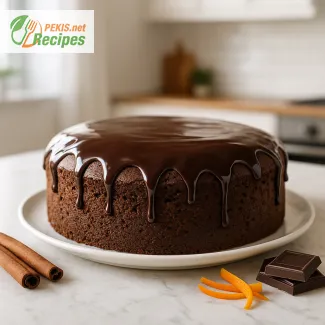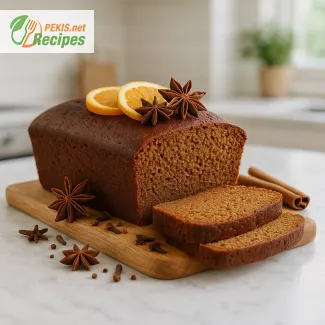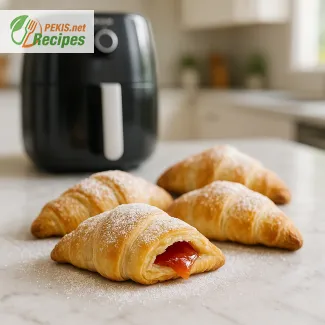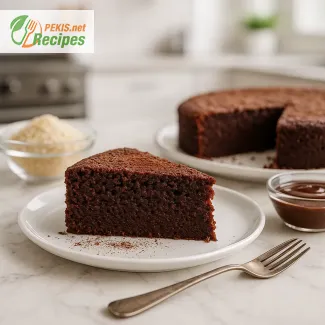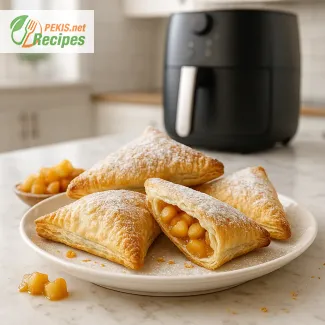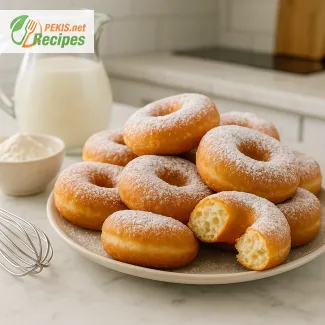Silky, melt-in-your-mouth Santa’s Chocolate Pralines bring together rich dark chocolate, warm vanilla, and a velvety cream base that sets into smooth, festive bites. Each praline captures the feeling of holiday evenings, when the kitchen fills with the aroma of melted cocoa and soft butter. Inspired by traditional European confectionery, these glossy little treats combine a creamy center with a gentle snap, creating a luxurious texture that feels both nostalgic and celebratory. Perfect for gifting, sharing, or savoring slowly during winter nights.
Years of working with chocolate textures taught that the smallest details—like how warm the cream is or how finely the chocolate is chopped—can completely transform the final bite. A simple trick that always elevates pralines is letting the mixture rest just a little longer than expected; that extra pause creates a smoother, silkier melt when they hit the tongue. These small refinements turn an ordinary batch into something that feels truly crafted.
PEKIS – professional chef and recipe developer with more than 25 years of experience in cooking and baking, specialized in European and international cuisine.
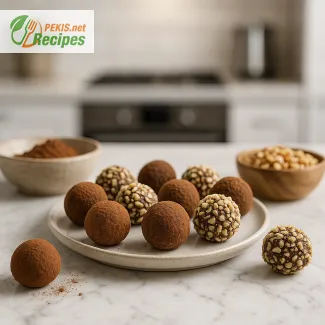
Santa’s Chocolate Pralines as a Festive Indulgence
A rich holiday bite shaped by smooth chocolate and warm seasonal notes
The first moment the melted chocolate coats the spoon, a familiar warmth fills the air—dense, aromatic, almost nostalgic. These silky pralines bring together a texture that hovers between creamy and delicately firm, offering a luxurious bite that softens instantly on the tongue. The mixture settles into tiny molds like a glossy midnight stream, capturing the essence of holiday evenings, when kitchens feel smaller, cozier, and full of anticipation. That same feeling appears again when the pralines are finally unmolded: a soft sheen, a gentle snap, and a fragrance that hints at cocoa, butter, and subtle spice undertones.
Their charm lies not only in the flavor but in the ritual—the slow stirring, the gentle cooling, the final dusting or dipping that turns simple ingredients into something intimate and celebratory. Every batch carries the quiet joy of crafting a treat that looks refined yet comes from a deeply homely place. These pralines embody festive generosity, a small but thoughtful gesture often shared in little boxes tied with ribbon. For many, this chocolate delight reflects traditions shaped generations ago, when handcrafted sweets were treasures exchanged during winter gatherings.
Holiday pralines trace their roots to the old European craft of confectionery, where sugar artisans perfected the balance between texture and sweetness. Over time, the recipe evolved into countless regional variations, from nut-filled centers to pure chocolate compositions. The version associated with Santa’s festive selection blends that history with modern simplicity, creating a treat that satisfies both nostalgia and present-day tastes.
A natural complement within this theme is a related chocolate treat, such as the classic truffle. An English version of that recipe is available here: Chocolate Truffles Recipe – Easy Homemade Pralines.
How ingredients influence flavor and texture
Chocolate sets the foundation, determining both richness and firmness. Butter softens the mixture and amplifies the velvety finish. Cream adds smoothness and rounds the intensity of cocoa. Nuts or fillings—if used—introduce crunch or aroma, while spices like cinnamon or vanilla create a festive warmth. Sweeteners influence the structure by adjusting how quickly the mixture sets and how glossy it appears. Each component shapes how the pralines break, melt, or linger on the palate.
Why you will love this recipe
- Smooth texture that melts effortlessly
- Festive flavor profile ideal for celebrations
- Simple method suitable even for beginners
- Versatile base for countless variations
- Elegant presentation perfect for gifting
Storage and make-ahead insights
Chilled pralines keep their structure exceptionally well and maintain their glossy exterior for several days when stored in an airtight container. The mixture can also be prepared ahead and refrigerated before shaping, ensuring flexibility during busy holiday weeks. They travel well, making them suitable for gifting or assembling dessert platters in advance.
Ingredient behavior and practical notes
- Chocolate: Defines structure and creaminess; higher cocoa content intensifies flavor.
- Butter: Adds softness and enhances melting quality.
- Cream: Stabilizes the texture and brings smoothness.
- Fillings (nuts, dried fruit, spices): Adjust aroma and give contrast.
- Sweeteners: Affect firmness and overall balance.
Creative variations
- Swap classic dark chocolate for white chocolate with vanilla notes.
- Fold in crushed nuts for added crunch.
- Add a thin cocoa coating for a rustic look.
- Infuse cream with orange zest or coffee for aromatic depth.
- Shape pralines into small festive molds for themed presentations.
Seasonal entity-based insights: Santa’s holiday confections
This type of praline often appears in traditional winter dessert assortments, combining influences from European festive kitchens and modern holiday flavor trends. The blend of chocolate richness and approachable technique makes it a staple in holiday dessert collections while remaining adaptable for different tastes and celebrations.
More reasons this festive treat stands out
- Small portions suitable for sharing
- Rich cocoa depth without overwhelming sweetness
- Easy gifting option for personal touches
- Warm seasonal aroma with optional spice enhancements
Flavor-focused highlights
- Cocoa-forward aroma that defines the praline character
- Creamy interior balanced with smooth chocolate coating
- Customizable fillings for personal twists
- Finely chop the dark chocolate and place it into a heatproof bowl.
- Warm the heavy cream in a small saucepan over medium heat until it reaches a gentle simmer (about 90°C (Fahrenheit)).
- Pour the hot cream over the chopped chocolate and let it rest for 1 minute to soften.
- Stir slowly until the chocolate melts into a smooth, glossy mixture.
- Add unsalted butter and vanilla extract, stirring until fully incorporated.
- Let the mixture cool at room temperature for 10 minutes, then refrigerate for 40–60 minutes until firm enough to shape.
- Using a small scoop or teaspoon, portion the chocolate mixture and roll it between your palms to form uniform balls.
- Coat half of the pralines in cocoa powder (for coating) and roll the remaining ones in crushed nuts (for decoration).
- Refrigerate again for 10–15 minutes to set the coating.
- Store in an airtight container until serving.
FAQ questionHow firm should the chocolate praline mixture be before shaping?
The mixture should be soft but moldable, similar to a thick truffle ganache. After chilling, it needs to hold its shape when scooped, but still feel smooth and pliable when rolled between your palms. If it is too runny, chill it longer in the refrigerator, stirring once halfway to ensure even cooling. If it becomes too hard, let it sit at room temperature for a few minutes; the fat in the chocolate and butter will soften slightly, making it easier to form neat, even pralines without cracks.
FAQ questionWhat type of chocolate works best for Santa’s chocolate pralines?
For this recipe, dark chocolate around 70% cocoa gives the best balance of richness, sweetness, and structure. Higher cocoa percentages create a more intense, slightly bitter flavor and a firmer texture, while lower cocoa content makes the pralines sweeter and softer. Using real couverture chocolate with a high cocoa butter content produces a particularly glossy, smooth praline. Avoid compound chocolate or products with added vegetable fats, as they can make the texture waxy and less velvety.
FAQ questionWhy does the chocolate and cream mixture sometimes split or look grainy?
A split or grainy ganache usually means the temperature balance was off. If the cream is too hot, it can cause the cocoa solids and fat in the chocolate to separate. If it is too cool, the chocolate may not melt evenly, leading to small unmelted bits. To fix a split mixture, gently warm the bowl over a bain-marie and whisk in a tablespoon of warm cream at a time until the texture becomes smooth and glossy again. Always pour hot but not boiling cream over finely chopped chocolate and let it sit briefly before stirring, so the heat distributes evenly.
FAQ questionHow long can homemade chocolate pralines be stored and how should they be kept?
These pralines keep well for 5–7 days when stored in an airtight container in the refrigerator. The cool environment helps maintain a stable texture and prevents the chocolate from blooming (forming a pale, dusty film on the surface). For serving, it is best to let them rest at room temperature for about 10–15 minutes, so the centers soften slightly and the flavor of cocoa and vanilla becomes more pronounced. Keep them away from strong-smelling foods, as chocolate easily absorbs surrounding aromas.
FAQ questionIs it necessary to temper the chocolate for this praline recipe?
Because the recipe relies on a ganache-style center rather than a hard shell, strict tempering is not essential. The pralines will still set nicely and taste rich and smooth. However, if the goal is a more professional look with a firmer snap and extra shine, tempering the chocolate used for an outer coating can elevate the finish. For most home preparations, simply ensuring the mixture is cooled and chilled correctly is enough to achieve satisfying, melt-in-the-mouth pralines suitable for festive platters and gifting.
FAQ questionHow can the basic recipe be adapted for different flavors without ruining the texture?
The safest way to vary flavor is through infusing the cream or adding small amounts of complementary ingredients. Infuse the cream with orange zest, coffee, tea, or warm spices (like cinnamon or cardamom), then strain before pouring it over the chocolate. For mix-ins, keep additions like finely chopped nuts, dried fruit, or cookie crumbs to modest quantities so they don’t overpower the ganache or make it crumbly. Coatings such as cocoa powder, finely ground nuts, or chocolate shavings adjust flavor and appearance without disturbing the smooth interior, preserving the characteristic creamy, indulgent texture of Santa’s chocolate pralines.
A batch of Santa’s chocolate pralines brings together everything comforting about the holiday season—rich cocoa aroma, soft buttery notes, and that gentle melt that lingers just long enough to feel indulgent. Each praline captures a moment of winter warmth, offering a smooth bite that blends silky chocolate with festive depth.
Handcrafted sweets have a way of creating quiet connection, and these pralines embody that feeling. Their creamy center and delicate coating turn simple ingredients into something memorable, whether shared at gatherings or enjoyed slowly at the end of the day. The balance of flavor and texture makes them a timeless addition to any dessert table.
Working with chocolate highlights how small details shape results, and these pralines show how thoughtfully chosen ingredients can elevate even the simplest treat. The combination of dark chocolate, cream, and vanilla forms a base that feels both classic and endlessly adaptable, allowing each batch to reflect personal style or seasonal moods.
These pralines offer more than sweetness—they invite a return to slower moments, familiar rituals, and the joy of creating something meaningful by hand. Their elegance, paired with their melt-in-the-mouth richness, makes them a standout festive indulgence.
Allergens present in the recipe
- Milk – present in chocolate, cream, and butter
- Tree nuts – if crushed nuts are used for decoration
- Soy – may be present depending on the chocolate brand
Gluten: This recipe is naturally gluten-free if using certified gluten-free chocolate.
How to remove allergens
- Replace heavy cream with coconut cream to avoid milk.
- Use dairy-free chocolate and vegan butter for a fully dairy-free version.
- Omit crushed nuts and use cocoa only for coating to avoid tree nuts.
- Choose soy-free chocolate if soy is an issue.
- Calcium (mg): 8 – supports bone health
- Iron (mg): 1.2 – contributes to oxygen transport
- Magnesium (mg): 18 – supports muscle and nerve function
- Potassium (mg): 95 – helps maintain fluid balance
- Vitamin A (mcg): 14 – supports vision and immunity
- Flavonoids (mg): 38 – contribute to heart and vascular health
- Polyphenols (mg): 55 – support cellular protection
- Catechins (mg): 12 – help reduce oxidative stress
